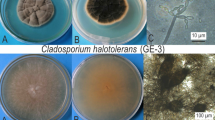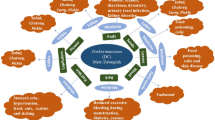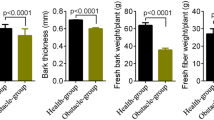Abstract
Endophytes, important plant-associated mycobionts, have attracted a great deal of attention because of their bioactive secondary metabolites. Even though halophytes have been reported to overcome salt stress via associations with their endophytes, few studies have investigated the metabolites produced by the endophytes from halophytes. In this study, a dark septate endophytic fungal strain (JS0464), identified as Gaeumannomyces sp. by ITS sequencing, was isolated from the rhizome of a halophyte, Phragmites communis, in Suncheon bay, South Korea. This strain was cultured on a large scale and extracted with ethyl acetate. Chemical investigations of extracts of JS0464 led to the isolation of two glycosylated dialkylresorcinol derivatives (1–2), an anthraquinone derivative (3) and eight known compounds (4–11), which were identified by spectroscopic analyses incorporating one-dimensional/2D NMR and MS. Nine compounds showed significant nitric oxide reduction activity in lipopolysaccharide-stimulated microglia BV-2 cells, seven of which did not impair cell viability. The results suggest that endophytes from the halophytes could be potential resources for bioactive natural products.
Similar content being viewed by others
Log in or create a free account to read this content
Gain free access to this article, as well as selected content from this journal and more on nature.com
or
References
Tan, R. X. & Zou, W. X. Endophytes: a rich source of functional metabolites. Nat. Prod. Rep. 18, 448–459 (2001).
Su, Z. Z. et al. Evidence for biotrophic lifestyle and biocontrol potential of dark septate endophyte harpophora oryzae to rice blast disease. PLoS ONE 8, e61332 (2013).
Pudhom, K. & Teerawatananond, T. Rhytidenones A–F, Spirobisnaphthalenes from Rhytidhysteron sp. AS21B, an endophytic fungus. J. Nat. Prod. 77, 1962–1966 (2014).
Strobel, G. A. et al. Oocydin A, a chlorinated macrocyclic lactone with potent anti-oomycete activity from Serratia marcescens. Microbiology 145, 3557–3564 (1999).
Castillo, U. F. et al. Munumbicins, wide-spectrum antibiotics produced by Streptomyces NRRL 30562, endophytic on Kennedia nigriscans. Microbiology 148, 2675–2685 (2002).
Sgroy, V., Cassan, F., Masciarelli, O., Del Papa, M. F. & Luna, V. Isolation and characterization of endophytic plant-growth promoting or stress homeostasis-regulating bacteria associated to the halophyte Prosopis strombulifera. Appl. Microbiol. Biotechnol. 85, 371–381 (2009).
Suryanarayanan, T. S. & Kumaresan, V. Endophytic fungi of some halophytes from an estuarine mangrove forest. Mycol. Res. 104, 1465–1467 (2000).
Yuan, Z. L., Lin, F. C., Zhang, C. L. & Kubicek, C. P. A new species of Harpophora (Magnaporthaceae) recovered from healthy wild rice (Oryza granulata roots, representing a novel member of a beneficial dark septate endophyte. Fems. Microbiol. Lett. 307, 94–101 (2010).
Sieber, T. N. In Plant Roots: The Hidden Half 3rd edn (eds Waisel Y., Eshel A. & Kafkafi U.) Ch. 49, pp 887–917 (Marcel Dekker, 2002)..
Yuan, Z. L., Zhang, C. L., Lin, F. C. & Kubicek, C. P. Identity, diversity, and molecular phylogeny of the endophytic mycobiota in the roots of rare wild rice (Oryza granulate from a nature reserve in Yunnan, China. Appl. Environ. Microbiol. 76, 1642–1652 (2010).
Choi, J. H., Kim, I. S., Kim, J. I., Kim, D. W. & Yoon, T. H. Effect of reed root (Phraamites communis extract on physiological activity of rats. Kor. J. Gerontol. 3, 109–115 (1993).
Stodola, F. H., Weisleder, D. & Vesonder, R. F. A new dialkylresorcinol from Stemphylium majusculum. Phytochemistry 12, 1797–1798 (1973).
Liu, Q. et al. Antiproliferative cardiac glycosides from the latex of Antiaris toxicaria. J. Nat. Prod. 76, 1771–1780 (2013).
Li, D. L., Li, X. M. & Wang, B. G. Natural anthraquinone derivatives from a marine mangrove plant-derived endophytic fungus Eurotium rubrum: structural elucidation and DPPH radical scavenging activity. J. Microbiol. Biotechnol. 19, 675–680 (2009).
Fujimoto, H., Nakamura, E., Okuyama, E. & Ishibashi, M. Six immunosuppressive features from an ascomycete, Zopfiella longicaudata, found in a screening study monitored by immunomodulatory activity. Chem. Pharm. Bull. 52, 1005–1008 (2004).
Ohtani, K., Fujioka, S., Kawano, T., Shimada, A. & Kimura, Y. Z. Nematicidal activities of 4-hydroxyphenylacetic acid and oidiolactone D produced by the fungus Oidiodendron sp. Z. Naturforsch. C 66, 31–34 (2001).
Wang, W., Guo, J., Zhang, J., Peng, J., Liu, T. & Xin, Z. Isolation, identification and antioxidant activity of bound phenolic compounds present in rice bran. Food Chem. 171, 40–49 (2015).
Fangkrathok, N., Sripanidkulchai, B., Umehara, K. & Noguchi, H. Bioactive ergostanoids and a new polyhydroxyoctane from Lentinus polychrous mycelia and their inhibitory effects on E2-enhanced cell proliferation of T47D cells. Nat. Prod. Res. 27, 1611–1619 (2013).
Lee, I. S. et al. Cytotoxicity of ergosterol derivatives from the Fruiting Bodies of Hygrophorus russula. Nat. Prod. Sci 17, 85–89 (2011).
Yaoita, Y. et al. Sterol constituents from five edible mushrooms. Chem. Pharm. Bull. 46, 944–950 (1998).
Yu, B. C., Yang, M. C., Lee, K. H., Kim, K. H. & Lee, K. R. Norsesquiterpene and steroid constituents of Humulus japonicus. Nat. Prod. Sci. 13, 332–336 (2007).
Liu, B. & Hong, J. S. Role of microglia in inflammation-mediated neurodegenerative diseases: mechanisms and strategies for therapeutic intervention. J. Pharmacol. Exp. Ther. 304, 1–7 (2003).
Ayer, W. A. & Trifonov, L. S. Anthraquinones and a 10-Hydroxyanthrone from Phialophora alba. J. Nat. Prod. 57, 317–319 (1994).
Gill, M. & Morgan, P. M. New fungal anthraquinones. Arkivoc 7, 145–156 (2001).
Yang, Y. et al. Anthraquinone derivatives from Rumex plants and endophytic Aspergillus fumigatus and their effects on diabetic nephropathy. Bioorg. Med. Chem. Lett. 23, 3905–3099 (2013).
Na, M. K., Jin, W. Y., Min, B. S., Ahn, J. S. & Bae, K. Protein tyrosine phosphatase 1B inhibitory activity of anthraquinones and stilbenes. Nat. Prod. Sci. 14, 143–146 (2008).
Hong, Y. J., Jang, A. R., Jang, H. J. & Yang, K. S. Inhibition of nitric oxide production, iNOS and COX-2 expression of ergosterol derivatives from Phellinus pini. Nat. Prod. Sci. 19, 147–152 (2012).
Sugano, M. & Tsuji, E. Rice bran oil and cholesterol metabolism. J. Nutr. 127, 521S–524S (1997).
Loizou, S., Lekakis, I., Chrousos, G. P. & Moutsatsou, P. Beta-sitosterol exhibits anti-inflammatory activity in human aortic endothelial cells. Mol. Nutr. Food Res. 54, 551–558 (2010).
Oka, T. et al. Cycloartenyl ferulate, a component of rice bran oil-derived gamma-oryzanol, attenuates mast cell degranulation. Phytomedicine 17, 152–156 (2010).
Kong, C. K. L. et al. A rice bran polyphenol, cycloartenyl ferulate, elicits apoptosis in human colorectal adenocarcinoma SW480 and sensitizes metastatic SW620 cells to TRAIL-induced apoptosis. Biochem. Pharmacol. 77, 1487–1496 (2009).
White, T. J., Bruns, T. D., Lee, S. D. & Taylor, J. W. in PCR Protocols: A Guide to Methods and Applications (eds Innis M. A., Gelfand D. H., Sninsky J. J. & White T. J.) Ch. 38, 315–322 (Academic Press, 1990)..
Acknowledgements
This research was supported by the National Institute of Biological Resources (NIBR201626101), Korea Institute of Planning and Evaluation for Technology in Food, Agriculture, Forestry and Fisheries (IPET) through High Value-added Food Technology Development Program, funded by Ministry of Agriculture, Food and Rural Affairs (MAFRA)(116001-3), and also Basic Science Research Program through NRF funded by the Ministry of Education (NRF-2015R1D1A1A01057914).
Author information
Authors and Affiliations
Corresponding author
Ethics declarations
Competing interests
The authors declare no conflict of interest.
Additional information
Supplementary Information accompanies the paper on The Journal of Antibiotics website
Supplementary information
Rights and permissions
About this article
Cite this article
Lee, C., Kim, S., Li, W. et al. Bioactive secondary metabolites produced by an endophytic fungus Gaeumannomyces sp. JS0464 from a maritime halophyte Phragmites communis. J Antibiot 70, 737–742 (2017). https://doi.org/10.1038/ja.2017.39
Received:
Revised:
Accepted:
Published:
Issue date:
DOI: https://doi.org/10.1038/ja.2017.39
This article is cited by
-
Protection of paper manuscripts by antimicrobial polyphenolic compounds from fungal extracts and antioxidant nanoparticles
npj Heritage Science (2025)
-
Do all fungi have ancestors with endophytic lifestyles?
Fungal Diversity (2023)
-
Endophytic fungi: a potential source for drugs against central nervous system disorders
Brazilian Journal of Microbiology (2023)
-
Insights into the beneficial roles of dark septate endophytes in plants under challenging environment: resilience to biotic and abiotic stresses
World Journal of Microbiology and Biotechnology (2022)
-
Bioactive compounds from an endophytic fungi Nigrospora aurantiaca
Botanical Studies (2021)



